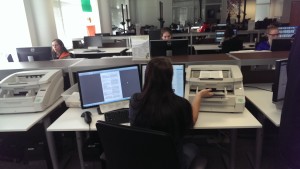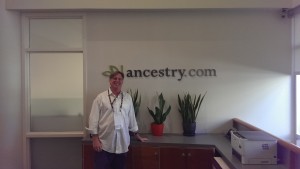Shar Mansukhani & John Hilbert of Heir Hunters International Visit the Headquaters of Ancestry.com in Provo, Utah.
- May, 24, 2015
- John Hilbert
- Genealogical and probate research finding missing heirs and unclaimed money
- No Comments.
Earlier this year, Ancestry.com announced the building of a new corporate headquarters. Shar Mansukhani and John Hilbert, principals of Heir Hunters International, toured Ancestry’s current “campus” in Provo, Utah, in 2014. Few of the millions who use the site and its affiliates ever have the opportunity to visit the headquarters, so they wanted to share what they saw of Ancestry’s inner workings.
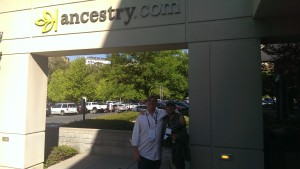
John Hilbert of Heir Hunters International and Daniel Jurca, a Romanian researcher, at the entrance to Ancestry.com’s corporate headquarters in Provo, Utah.
While attending the July 2014 meeting of the International Conference of Jewish Genealogical Societies in Salt Lake City, Ancestry kindly arranged a tour for thirty or so attendees.
After a journey of about forty-five miles directly south from downtown Salt Lake City along I-45, the party arrived at Ancestry. During the trip, Ancestry’s Crista Cowan, better known as the “Bearfoot Genealogist,” entertained questions.
After dividing the visitors into groups of ten, Ancestry assigned a tour guide to each grouping. Shar and John’s guide was Lisa.
The Ancestry Content Department
For the first stop on the tour, Shar and John met with Bryan, the head of of Ancestry’s Content Department.
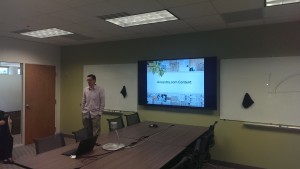
At the first stop on their tour of Ancestry’s head quarters Shar Mansukhani and John Hilbert, principals of Heir Hunters International, met Bryan, head of Ancestry’s Content Department.
In his opening remarks, Bryan read Ancestry’s Mission Statement.
Ancestry.com Mission Statement
Archives and repositories hold many of the records that comprise the collective written story of the past, the documents of our existence.
It is largely through these records that individuals are able to discover and tell the story of their ancestors.
Core to Ancestry.com’s mission is to make available and easily searchable, as many of these crucial, story telling documents and records as possible.
Ancestry spends tens of millions each year to help in the preservation and
access of records on the National, State, and Local level.
Ancestry’s Extraordinarily Large Content Offerings
Since few ever fully utilize Ancestry’s content (and it would be impossible to do so even if one wanted to), the amount of data on the site is extraordinary.
Bryan set forth the numbers.
Records on line: 14 billion
Member to member connections: 7 billion
Trees created: 60 million
Individual profiles: 6 billion
Pictures and stories uploaded: 200 million
Average records added daily: 2 million
And all of that data, Bryan noted, requires “10+ pentabytes” of storage. Bryan defined a “pentabyte” as approximately one million gigabytes, which is equal to 500,000,000 floppy discs or 200,000,000 four draw filing cabinets!
Ancestry Acquisitions
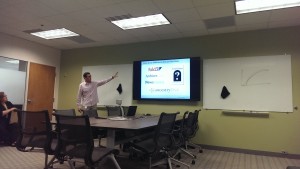
Shar Mansukhani and John Hilbert and all the researchers at Heir Hunters International utilize not only Ancestry.com, but its affiliated sites, such as Fold3.com for US military records, Archives.com for records from the National Archives, Findagrave.com to locate burial plots, and Newspapers.com for any relevant information when conducting an heir search, such as birth, marriage, and death announcements.
Not satisfied with simply offering its own product, and in a continuing effort to enhance the genealogical researcher’s experience, over the years Ancestry has acquired other websites. Bryan briefed the group on the more recent Ancestry offerings, which are:
Fold3.com, a source for U.S. military records
Newspapers.com, a source for over 3,500 US newspapers
Archives.com, a source for records from the U.S. National Archives
Findagrave.com, a listing of US burial plots
As it does with its primary website, Ancestry.com, the staff at Ancestry is constantly adding new source materials to its affiliated products.
AncestryDNA
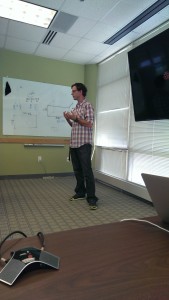
At their second stop on the tour of Ancestry’s campus, Shar Mansukhani and John Hilbert, principals of Heir Hunters International, met Finn, Senior Director of Product Management, AncestryDNA.
On their second stop, Shar and John met with Finn, who serves as the Senior Director of Product Management for AncestryDNA.
“AncestryDNA is,” proclaimed Finn, “the leader in DNA testing for family history and includes more than 850,000 genotyped members who have taken the AncestryDNA test.” Every individual who submits a DNA sample has access to Ancestry, he explained, the world’s largest online family history resource, which includes 65 million family trees and over 15 billion historical records.
For the latest developments in AncestryDNA, please see its most recent press release of April 12, 2015.
Website Security

Since photographs of its Web Security Room were strictly forbidden, this image taken from the web represents what the actual Security Bunker Shar Mansukhani and John Hilbert looked like on their tour of the Ancestry campus.
Lisa then escorted the group to an unmarked door. To their surprise, she explained, they would be permitted to enter the room where those charged with safeguarding Ancestry’s web security worked, or, more descriptively, “hunkered down.” Photographs, she admonished, were strictly forbidden.
She then opened the door, revealing a small dark room, bunker like, with the only light provided by, at least, twenty computer screens fixed though out, some on desks and others secured to the walls. The monitors ranged in size from massive 60-by-60 inch screens with others no more than 10-by-10 inches. Three individuals sat fixated on the displayed data. A Team Member explained that from the room, among other things, tests or “pings” are sent to Ancestry’s servers located all over the world to determine their efficiency. Other screens warn if hackers attack the site, which had in fact happened several weeks earlier.
One particular monitor caught Shar and John’s notice. On a black screen, a green line rose in dramatic fashion from the baseline or “zero” position, to a large peak, and then, precipitously, dropped back to the zero baseline. When asked what the line represented, a Team Member explained that line displayed the volume of Ancestry subscriptions on a time line, with the peak occurring during the airing of the Ancestry sponsored TLC Network show, Who Do You Think You Are?
Proving, we all agreed, Ancestry sponsorship money well spent.
Where The Rubber Meets the Road:
Duplicating Genealogical Primary Source Materials
Team Member Jeffrey began the discussion by explaining that Ancestry’s first step in the data retrieval process is securing primary genealogical source materials. Primary sources can be found on many types of material and media, including, for example, computer discs, picture slides, film stock, microfiche, and book registers. All material is handled according to stringent guidelines established by the National Archives.
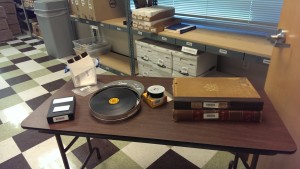
Primary sources can be found on many types of material and media, including, for example, computer discs, picture slides, film stock, microfiche, and book registers
The type of material determines the method by which the Ancestry team secures imagines of the data, which, once copied, Ancestry will store on its massive computer serves and then ultimately be made available to its users.
The Methods of Copying Genealogical Data
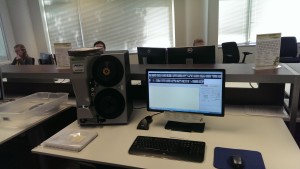
Ancestry uses a high-end Mekel Technology Mach 5 high speed scanner on film images which will be stored on Ancestry serves.
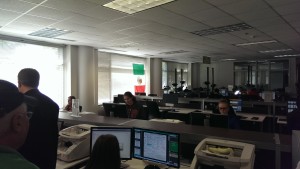
Ancestry Team Members silently operate their scanners, ensuring more genealogical data reaches its users.

Jeffrey explains how an Ancestry Team Member uses a high definition camera to photograph yearbook pages.
Checking the Look & Feel
To Insure Image Quality
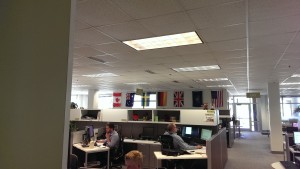
After the source material is scanned, but before offered to the pubic, Ancestry Team Members check its Look & Feel to judge its quality.
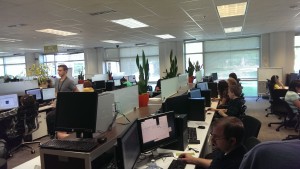
Ancestry Team Members at their computer terminals checking data Look & Feel prior to publishing to its sites.
The Ancestry Mobile App
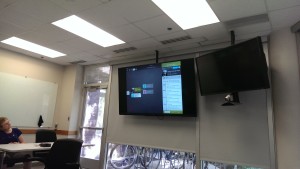
At one stop on their tour of the Ancestry campus, a Team Member explained to Shar Mansukhani and John Hilbert the features of the Ancestry Mobile App or “tree-to-go.”
For their next stop of their tour, a Team Member introduced Shar and John and the rest of their tour party to the Ancestry Mobile App. For a review of the Ancestry mobile app, or Ancestry’s “tree-to-go,” one should read a review from the website, Mobilegenealogy.com.
Family Tree Maker
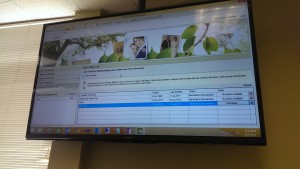
Ancestry Product Development Leader, Kevin, expounded on how the Family Tree Maker software and ones family tree integrate with the Ancestry website to Shar Mansukhani and John Hilbert with Heir Hunters International.
On the last leg of their tour, Ancestry Team Member Kevin, the leader of Product Development, demonstrated the latest features in Ancestry’s Family Tree Maker 2014. The software seamlessly integrates your family tree with the Ancestry website and its content.
Treats from the Shaky Leaf Cafe
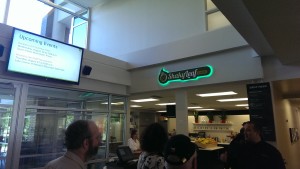
At their last stop on the tour of the Ancestry campus, Ancestry provided Shar Mansukhani and John Hilbert and their tour group with treats from the Shaky Leaf Cafe.
In winding up their visit, Ancestry graciously provided treats from its in-house restaurant, The Shaky Leaf Cafe.
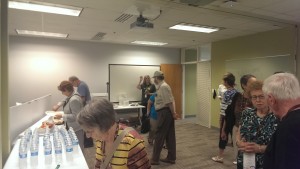
At the conclusion of their tour, Ancestry gave gifts bags and offered discounted AncestryDNA test kits and Family Tree Maker to Shar Mansukhani and John Hilbert and the tour members.
At its conclusion, Ancestry distributed small gift bags. Shar Mansukhani and John Hilbert also purchased several AncestryDNA kits for family members and several copies of the FamilyTree Maker 20104 software–all of which Ancestry offered at an discount to tour participants.
The tour left Shar and John with a greater appreciation for the intensive and continuing commitment Ancestry and its Team Members have for bringing to the world’s genealogical community extraordinary ever more content and resources. If you ever have the opportunity to visit Ancestry, you must do so. You’ll never forget it.
Recent Posts
- John Hilbert, Partner with Heir Hunters International, Appears on CNN’s Morning Show to Discuss Heirship Claims Procedure in the Estate of Prince Rogers Nelson, “Prince”
- Expert Opinion on the California Bed Bath & Beyond Court Decision
- 2nd Half of 2015, Utah Takes in $37.6 Million in Unclaimed Property
- Job Offer: State of Delaware Seeks Assistant of Unclaimed Property
- West Virginia Treasurer Purdue to Publish List of 12,000 People With Unclaimed Property and Unclaimed Money
Recent Comments
Archives
- May 2016
- April 2016
- March 2016
- September 2015
- August 2015
- May 2015
- April 2015
- March 2015
- February 2015
- January 2015
- November 2014
- December 2013
- November 2013
- October 2013


